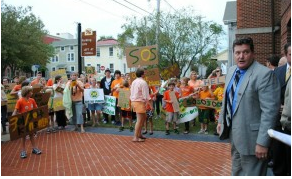
Commissioner Phil Dumenil meets demonstrators last fall outside Liberty Building. Photo From SOS facebook site.
The office of Governor O’Malley released a statement yesterday confirming that an additional $7.8 million has been allocated for the design phase of an overpass to span the US 301/ MD 304 intersection outside of Centreville.
The announcement comes after nine months of grassroots campaigning for the overpass induced by the tragic death of 15 year old Connor Rice, who lost his life in an accident in the intersection last fall. Rice’s death was the fifth in that particular intersection since 2005, catalyzing the community to take action in the form of a Facebook group, Support Overpass 4 Students , and a protest/march to raise awareness of the danger presented to all members of the community by the interchange.
Today, the page proudly includes the press release by O’Malley, a true testament to the power of social media in community activism.
“With this investment in the US 301/MD 304 interchange, we can keep our families and children safe as they travel to work, school and go about their daily lives,” said Governor O’Malley in the release.“Today, we move another step closer to separating local traffic from the truck and through traffic running on US 301 so that we can improve safety and better serve the needs of area residents. Together, we can work to improve this busy intersection.”
As a short-term solution, the state installed a J-turn, forcing east and westbound traffic on MD 304 to take a slower, more circuitous route either north or south along US 301 in order to traverse the highway. At the time of the protest in September, this was viewed as an inadequate response from the SHA and state by the citizens, and the community duly documented their dissatisfaction on the Support Overpass 4 Students site.
But the funding for a full scale overpass–which will cost around $60 million– simply was not there. Likewise, the funding earmarked by O’Malley today is meant to cover the design expenses, not the construction of the overpass. Members of Support Overpass 4 Students however, couldn’t be more thrilled with this recognition.
“It’s just a huge push forward, getting the 7.8 million, we really weren’t expecting this to happen so soon,” said organizer Nikki Pino who was sure to acknowledge several public officials, the students of Queen Anne’s County High School, and savvy social networking as “instrumental” to the organization’s success.
“We couldn’t have done this with the support of Senator Pipkin,County Administrator Gregg Todd, Delegates Smiegel, Hershey, and Jacobs,” she said. “In the case of State Treasurer Nancy Kopp, we prepared a bus ride for her to see what students go through daily, and now she completely understands.”
The planning phase is expected to take another two years, after which the building stage will begin.
The timing for this overpass comes at a critical juncture in the growth of Queen Anne’s County. According to the most up to date information on QAC’s population from the U.S. Census Bureau, the county swelled by 17% between 2000 and 2010. The state of Maryland, meanwhile, has on average only experienced a growth rate of 9% during this same interval.
Traffic density in the QAC area is only expected to reflect these growth trends, with the SHA projecting US 301 to carry about twice the traffic it does today by 2030. Thus, the activism of the Support Overpass 4 Students group has been particularly prescient, while uniting a community under a common cause at the same time.
“We all are pushing for the same goal,” said Pino. “Everybody understands how much that intersection needs to be changed–but the fight has not ended. In any case, we’ll take $7.8 million and run with it, and hopefully we’ll start digging in a few years.”
.



[…] the design phase of an overpass to span the US 301/ MD 304 intersection outside of Centreville. The intersection has seen five fatalities since 2005, writes Simon Kelly for the Talbot […]